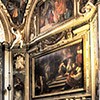Chapel of Saint Hyacintha Marescotti – a place where the senses struggle against virtue
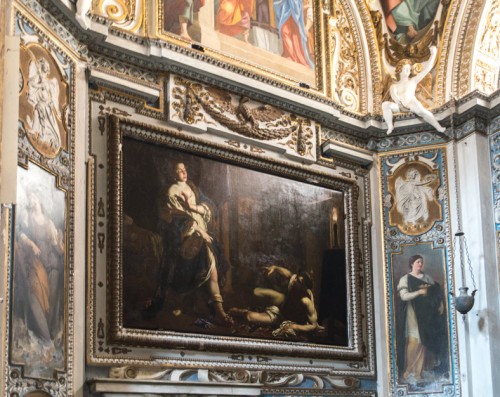
Temptation of Saint Francis, Simon Vouet, chapel of St. Hyacintha Marescotti (Alaleoni), Church of San Lorenzo in Lucina
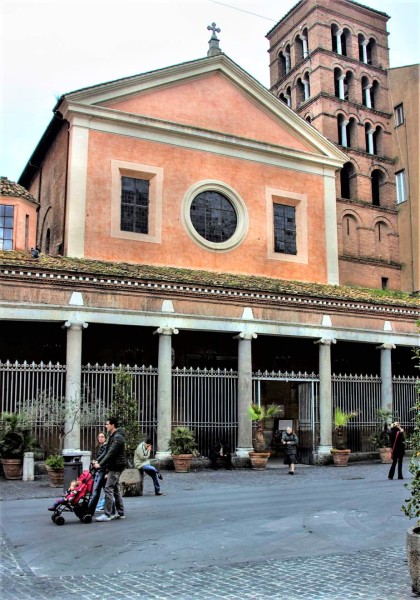
Church of San Lorenzo in Lucina, facade

Church of San Lorenzo in Lucina, chapel of Saint Hyacintha Marescotti (Alaleoni), right - Abandonment of the robes by Saint Francis, Simon Vouet
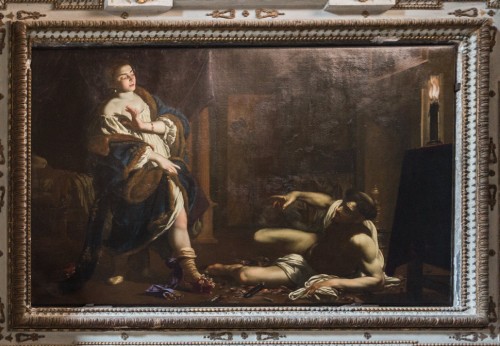
Temptation of Saint Francis, Simon Vouet, chapel of St. Hyacintha Marescotti (Alaleoni), Church of San Lorenzo in Lucina
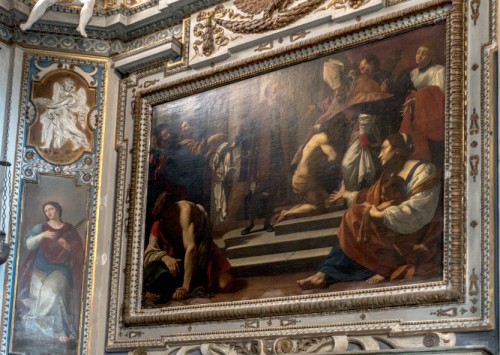
Chapel of St. Hyacintha Marescotti (Alaleoni), Abandonment of Clothes by Saint. Francis, Simon Vouet, Church of San Lorenzo in Lucina
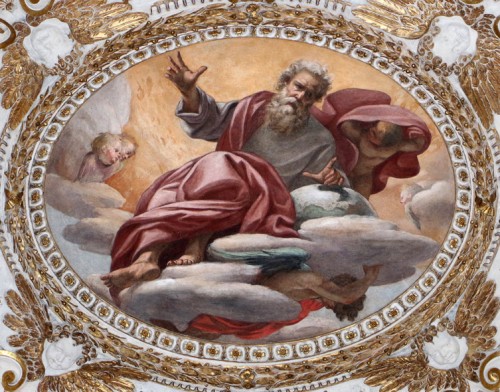
Alaleoni Chapel, Church of San Lorenzo in Lucina, central fresco of the vault, Simon Vouet, pic.Wikipedia

Alaleoni Chapel, Church of San Lorenzo in Lucina, Birth of the Virgin, Simon Vouet's workshop, pic. Wikipedia
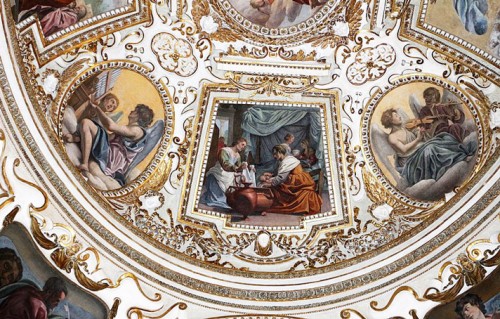
Alaleoni Chapel, Church of San Lorenzo in Lucina, Birth of the Virgin, Simon Vouet's workshop, pic.Wikipedia
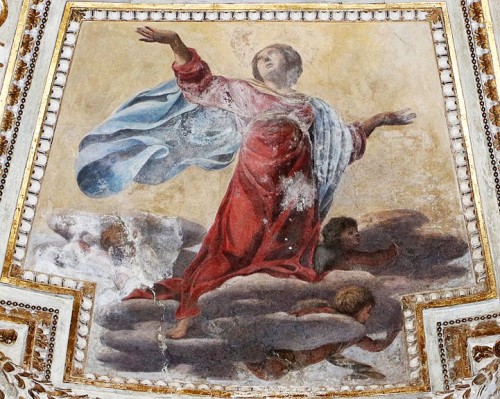
Alaleoni Chapel, Church of San Lorenzo in Lucina, Assumption, Simon Vouet's workshop, pic.Wikipedia
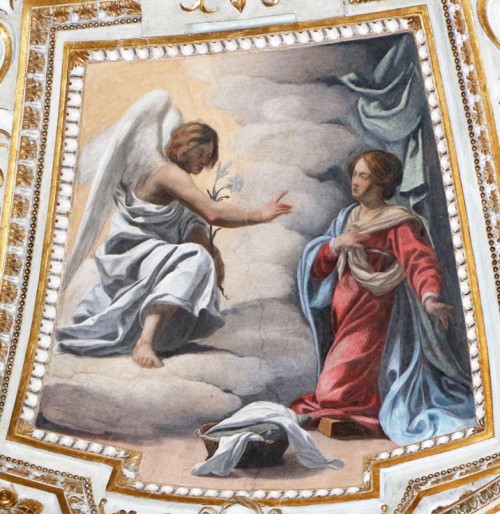
Alaleoni Chapel, Church of San Lorenzo in Lucina, Visitation, Simon Vouet's workshop, pic Wikipedia
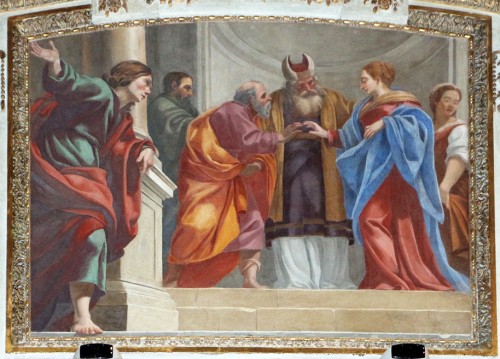
Alaleoni Chapel, Church of San Lorenzo in Lucina, Presentation in the temple, Simon Vouet's workshop, pic Wikipedia
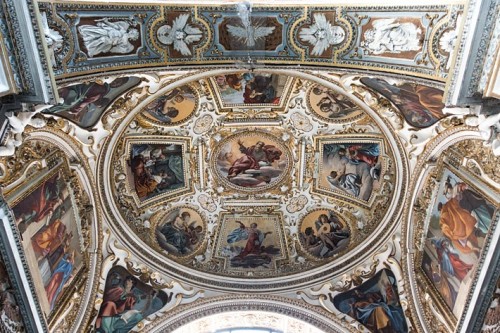
Alaleoni Chapel, chapel vault, church of San Lorenzo in Lucina, Simon Vouet and workshop
It is not often that we can see paintings in situ, meaning in their original location. Protected from theft, damage, and adverse weather conditions they have generally made their way to art galleries and museums where they can be viewed under sterile conditions. Unfortunately, because of this, they have lost their original context, there is no light that illuminated them and the perspective from which they were admired or adored. However, Rome still boasts some paintings that from the moment of their creation have not changed their location and constantly await to be discovered and admired.
It is not often that we can see paintings in situ, meaning in their original location. Protected from theft, damage, and adverse weather conditions they have generally made their way to art galleries and museums where they can be viewed under sterile conditions. Unfortunately, because of this, they have lost their original context, there is no light that illuminated them and the perspective from which they were admired or adored. However, Rome still boasts some paintings that from the moment of their creation have not changed their location and constantly await to be discovered and admired.
A place that is truly exceptional in this regard is a chapel in the Church of San Lorenzo in Lucina where we can see interesting frescoes, but above all two outstanding paintings. However, before moving on to them, let us immerse ourselves in the atmosphere of this beautiful church which is famous for at least three items found within its walls. The first is the magnificent, thoroughly original painting The Crucifixion (Guido Reni), seen in the main altar, the second is the bust of Gabriele Fonseca by Gian Lorenzo Bernini, and the third, a painting by Carlo Saraceni depicting Saint Charles Borromeo.
When we have had our fill of these extraordinary works, it is worth visiting a chapel located near the main altar (fifth from the left looking from the entrance), at the present dedicated to Hyacintha (Giacinta) Marescotti. The image of this little-known saint, alive in the XVII century, can be found in the main altar, but let us first focus on the Baroque décor of the chapel.

The chapel was erected in the XVI century (1578) and belonged to the master of ceremonies at the court of Pope Gregory XIII, Lodovic Branco de Firmaniso, and was dedicated to Our Lady of Grace (Madonna delle Grazie), as well as Saint Francis. The initial decoration has not been preserved apart from one painting presently located above the main altar of the chapel, depicting Madonna delle Grazie. It is the work of Girolamo Siciolante de Sermoneta (1521-1580), who was most likely also the author of the altarpiece and the original décor of the chapel. After the death of Lodovic Branco (1587), the chapel was inherited by his nephew – Paolo Alaleone (Alaleoni), who decided to modernize it for the glory of his name and the patrons adorned within. We do not know too much about the client himself, despite a journal that he had diligently kept since 1582, meaning from the moment he (similarly to his uncle) took over the post of papal master of ceremonies. He was tasked with maintaining the pope's protocol, assigning where and next to whom someone would sit, walk in a procession, or who would visit the pope. He also participated in delegations during state weddings and in other official ceremonies. He was a diligent man, who was deeply convinced of the importance of his function. He died at an old age (1643), meaning exactly twenty years after the creation of the chapel. This rather egocentric man, who had little interest in the world (which is testified to by the aforementioned journals), commissioned the most outstanding artist to decorate his place of eternal rest. This was the French painter and protégé of the Barberini family – Simon Vouet. We are aware of the contract concluded between the client and the artist in 1622. In it, we can read that the artist was obliged to create fresco paintings in the upper part of the chapel as well as two canvases in its lower part, as well as to make some alterations to the existing altarpiece in the chapel (?). The contract encompasses a sum of five hundred scudos, and apart from that the painter was to receive an additional three hundred scudos for materials. Upon completion of the commission, meaning after the declared six months, the artist could ask for an additional fifty scudos if the work pleased the owner of the chapel. As we know Vouet did not finish his work until August of 1624, yet despite the delay he still received the fifty scudo bonus, which proved that the client was pleased with his work. At that time, Vouet became the most important person on the artistic stage of the Eternal City – in October he was selected to be the head of the Academy of St. Luke, thanks to which both his renown and prestige skyrocketed.

The most interesting items in the chapel are two oil paintings depicting scenes from the life of St. Francis. The first of these shows the saint taking off his robes, in a symbolic way renouncing his current life and returning them to his father (Saint Francis Renouncing His Goods). He comes out onto the square completely nude, now serving only God. The second painting shows Francis accompanied by a woman of easy virtue (Temptation of St. Francis) and this time he is also nude but is completely oblivious to the woman's charm. We may say, that the motto of both the representations is nudity shown as purity of soul and heart. The light coming in through the semi-circular window found above the main altar of the chapel illuminates both nocturnes bringing the bare limbs of the saint out of the darkness. And it is at this moment that we can understand the principal idea of the creator of the chapel and see the significance of coming in contact with paintings in a place for which they were destined. The virtue of Francis's purity is symbolized by the light that conquers the darkness of sin and immorality, and to achieve this effect the artist used two different kinds of light: artificial – coming from his canvases – and natural, coming in from the outside. Does the painting not remind us of the words of St. Paul: "The night is far gone; the day is at hand. So then let us cast off the works of darkness and put on the armor of light!” (Rom. 13, 12)?

The painting decorations of the dome and the chapel walls with frescoes supplemented with stuccos was yet another task entrusted to Vouet, which he completed most likely along with some collaborators, however, historians have differing views on the subject. These works are definitely not up to par with the outstanding oil paintings. There are interesting frescoes found above them, which depict The Marriage of the Virgin and The Visitation. In the center of the dome, adorned with frames of gilded stucco, we can see God the Creator represented in a style reminiscent of the creation of Michelangelo (Vault of the Sistine Chapel), and around it scenes from the life of Mary – immaculate since birth (The Birth of a Virgin, The Presentation of the Virgin at the Temple, The Annunciation, The Assumption of Mary). Among the medallions, we will see angel musicians, in the lunettes of the dome – the images of the four Evangelists.
However, this is not the end of the story of this chapel. The Alaleoni family lost the chapel, while their surname was forgotten. The subsequent owners – the Ruspoli family – took it over and dedicated it to Giacinta Marescotti, beatified in 1726, a saint who was related to them. Vouet's canvases were left untouched, however, the altarpiece was changed. It currently shows St. Hyacintha on her deathbed, as St. Francis appears to her. It was painted by Marco Benefial in 1736.
At the beginning of the XIX century (1807) the decorations of the chapel were further enriched by adding rectangular panels on each of the walls with the images of saints (Lucy, Peter, Paul, Catherine of Alexandria, Klara, and Mary Magdalene), which were completed by the popular at that time painter Francesco Manno. And this concluded the activities spanning several centuries with the aim of creating an interior that would correspond fully with the vision of the chapel owners. These decorations were created for the greater glory of God but above all personal glory. Today we do not remember their names, their history has been forgotten, but the works which they commissioned, such as those telling the story of Saint Francis – will remain with us constantly inspiring and amazing.















